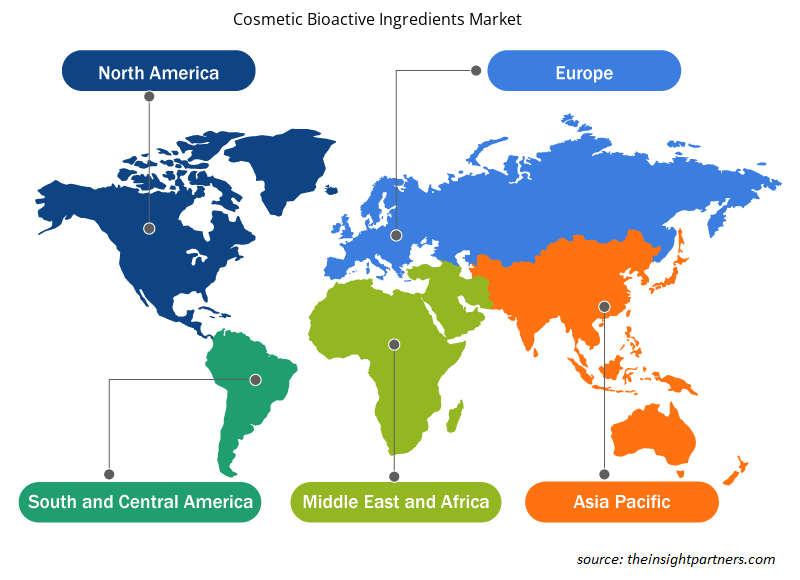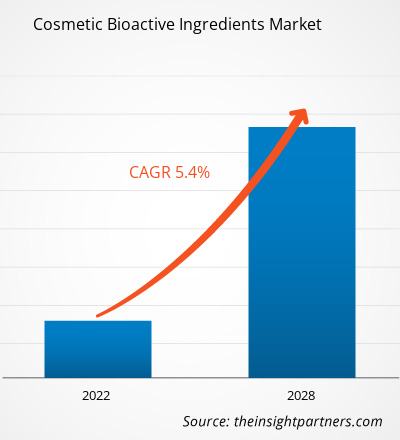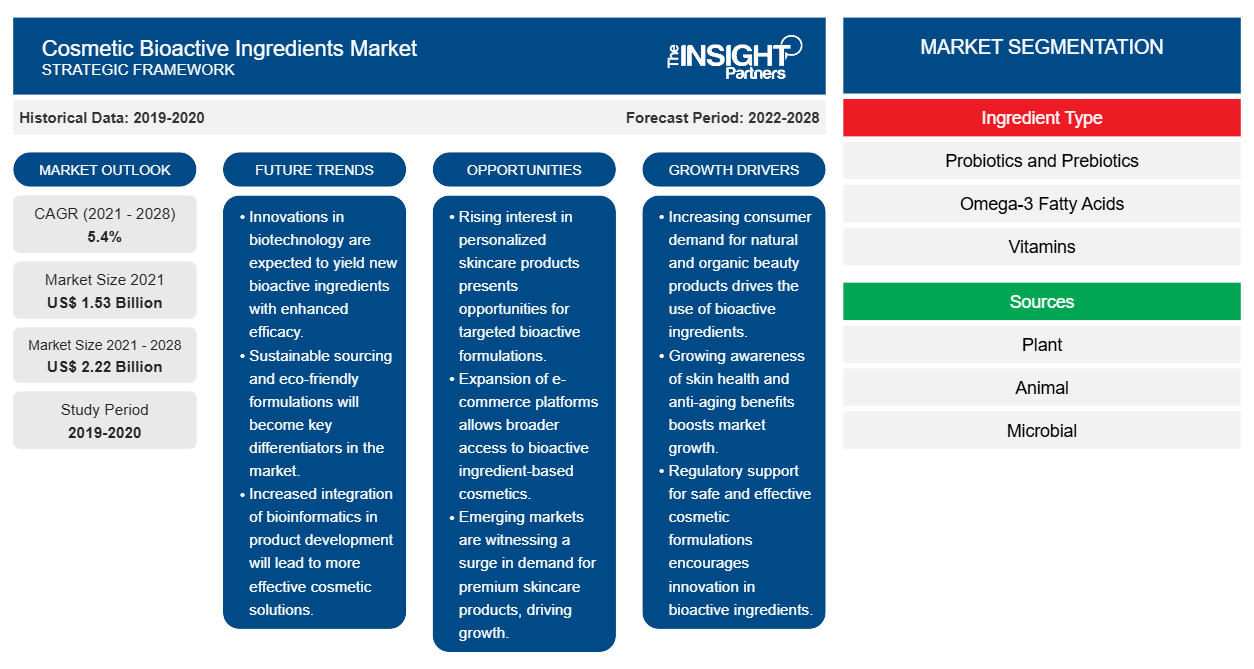화장품 생물학적 활성 성분 시장은 2021년 15억 2,991만 달러에서 2028년 22억 1,596만 달러로 성장할 것으로 예상되며, 2021년에서 2028년까지 연평균 성장률 5.4%로 성장할 것으로 추산됩니다.
화장품은 피부와 머리카락에 바르고, 정화하고, 매력을 증진하고, 외모를 개선하기 위해 만든 제품입니다. 이러한 유형의 제제에 일반적으로 사용되는 활성 성분 중에는 상업적 매력, 안전성 및 풍부한 구성으로 인해 식물성 원료 제품을 통합하는 전 세계적 추세가 있으며, 종종 시너지 효과 또는 다기능 효과와 관련이 있습니다. 식물 추출물은 구조적 다양성이 높은 식물에 존재하는 2차 대사산물이 풍부합니다. 플라보노이드와 비플라보노이드는 모두 광보호, 노화 방지, 보습, 항산화, 수렴, 자극 방지 및 항균 활동과 같은 흥미로운 화장품 특성과 관련이 있습니다. 이러한 생리활성 성분은 생물학적 성분과 약리학적 작용을 통해 피부과학적 이점을 제공하는 것으로 나타났으며 피부 재생, 광보호, 상처 치유 등에 잠재적으로 응용될 수 있습니다. 화장품 생리활성 성분 시장 성장은 주로 화장품에서 천연 성분에 대한 선호도가 높아지고 출시되는 생리활성 성분이 늘어나는 데 기인합니다. 그러나 엄격한 규제 프레임워크로 인해 화장품 생물학적 활성 성분 시장 성장이 제한되고 있습니다.
귀하의 요구 사항에 맞게 이 보고서를 사용자 정의하세요
이 보고서의 일부 또는 국가 수준 분석, Excel 데이터 팩을 포함하여 모든 보고서에 대한 사용자 정의를 무료로 받을 수 있으며 신생 기업 및 대학을 위한 훌륭한 혜택과 할인 혜택을 이용할 수 있습니다.
-
이 보고서의 주요 시장 동향을 알아보세요.이 무료 샘플에는 시장 동향부터 추정 및 예측까지 다양한 데이터 분석이 포함됩니다.
시장 통찰력
천연 제품에 대한 소비자 수요 증가로 화장품에 사용할 수 있는 생물학적 활성 물질과 관련된 연구가 촉진되고 있습니다. 유럽에는 BASF와 DSM과 같은 가장 큰 생물학적 활성 성분 제조업체와 개인 관리 브랜드가 몇 개 있습니다. 개인 관리 산업을 위한 생물학적 활성 성분의 출시가 시장 성장을 견인하고 있습니다. 2019년 6월, BASF Care Creations는 피부 수분 공급과 회춘을 제공하는 람부탄 나무를 사용하는 뷰티 시장을 위한 세 가지 새로운 활성 성분을 출시했습니다. 마찬가지로 2019년 4월, Lonza는 Aphanothece Sacrum 폴리사카라이드와 Galactoarabinan과 같은 천연 공급 성분과 물과 글리세린의 독특한 조합인 H2OBioEV 생물학적 활성 성분을 출시했습니다. 이 성분은 필수적인 보습제를 보충하여 보습 능력을 부여하여 강력한 표피 단백질 장벽을 형성하고 유지하기 위한 최적의 환경을 용이하게 합니다.
성분 유형 기반 통찰력
성분 유형에 따라 화장품 생물학적 활성 성분 시장은 프로바이오틱스와 프리바이오틱스, 오메가-3 지방산, 비타민, 카로티노이드와 항산화제, 식물 추출물, 미네랄, 아미노산, 단백질과 펩타이드 등으로 나뉩니다. 아미노산 세그먼트는 2021년에 시장에서 가장 큰 점유율을 차지할 가능성이 높습니다. 그러나 식물 추출물 세그먼트는 예측 기간 동안 시장에서 가장 높은 CAGR을 기록할 것으로 예상됩니다.
소스 기반 통찰력
화장품 생물학적 활성 성분 시장은 출처에 따라 식물, 동물 및 미생물로 세분화됩니다. 식물 세그먼트는 2021년에 시장에서 가장 큰 점유율을 차지할 가능성이 높습니다. 그러나 미생물 세그먼트는 예측 기간 동안 시장에서 가장 높은 CAGR을 기록할 것으로 예상됩니다.
화장품 생물학적 활성 성분 시장에서 활동하는 회사들은 제품 출시, 합병 및 인수, 협업, 제품 혁신, 제품 포트폴리오와 같은 전략을 채택하여 전 세계적으로 영향력을 확대하고, 브랜드 이름을 유지하며, 최종 사용자의 증가하는 수요를 충족하고 있습니다.
화장품 생물학적 활성 성분 시장 지역 통찰력
Insight Partners의 분석가들은 예측 기간 동안 Cosmetic Bioactive Ingredients Market에 영향을 미치는 지역적 추세와 요인을 철저히 설명했습니다. 이 섹션에서는 또한 북미, 유럽, 아시아 태평양, 중동 및 아프리카, 남미 및 중미의 Cosmetic Bioactive Ingredients Market 세그먼트와 지리에 대해서도 설명합니다.

- 화장품 생물학적 활성 성분 시장에 대한 지역별 데이터를 얻으세요
화장품 생물학적 활성 성분 시장 보고서 범위
| 보고서 속성 | 세부 |
|---|---|
| 2021년 시장 규모 | 15억 3천만 달러 |
| 2028년까지 시장 규모 | 22억 2천만 달러 |
| 글로벌 CAGR (2021-2028) | 5.4% |
| 역사적 데이터 | 2019-2020 |
| 예측 기간 | 2022-2028 |
| 다루는 세그먼트 |
성분 유형별
|
| 포함된 지역 및 국가 |
북아메리카
|
| 시장 선도 기업 및 주요 회사 프로필 |
|
화장품 생물학적 활성 성분 시장 참여자 밀도: 비즈니스 역학에 미치는 영향 이해
화장품 생물학적 활성 성분 시장 시장은 소비자 선호도의 변화, 기술 발전, 제품의 이점에 대한 인식 증가와 같은 요인으로 인해 최종 사용자 수요가 증가함에 따라 빠르게 성장하고 있습니다. 수요가 증가함에 따라 기업은 제품을 확장하고, 소비자의 요구를 충족하기 위해 혁신하고, 새로운 트렌드를 활용하여 시장 성장을 더욱 촉진하고 있습니다.
시장 참여자 밀도는 특정 시장이나 산업 내에서 운영되는 회사나 기업의 분포를 말합니다. 주어진 시장 공간에 얼마나 많은 경쟁자(시장 참여자)가 존재하는지 그 규모나 총 시장 가치에 비해 나타냅니다.
화장품 생물학적 활성 성분 시장에서 운영되는 주요 회사는 다음과 같습니다.
- 코닌클리크 DSM NV
- 아지노모토 주식회사
- 로케트 프레르
- 영어: ADM(영어)
- 바스프 SE
면책 조항 : 위에 나열된 회사는 어떤 특별한 순서에 따라 순위가 매겨지지 않았습니다.

- 화장품 생물학적 활성 성분 시장 주요 주요 업체 개요를 알아보세요
화장품 생물학적 활성 성분 시장 –성분 유형
- 프로바이오틱스와 프리바이오틱스
- 오메가-3 지방산
- 비타민
- 카로티노이드와 항산화제
- 식물 추출물
- 탄산수
- 아미노산
- 단백질과 펩타이드
- 기타
화장품 생물학적 활성 성분 시장 – 출처별
- 식물
- 동물
- 미생물
화장품 생물학적 활성 성분 시장 – 지리별
-
북아메리카
- 우리를
- 캐나다
- 멕시코
-
유럽
- 프랑스
- 독일
- 이탈리아
- 영국
- 스페인
- 유럽의 나머지 지역
-
아시아 태평양(APAC)
- 중국
- 인도
- 대한민국
- 일본
- 호주
- 아시아 태평양의 나머지 지역
-
중동 및 아프리카(MEA)
- 남아프리카 공화국
- 사우디 아라비아
- 아랍에미리트
- 중동 및 아프리카의 나머지 지역
-
남미(SAM)
- 브라질
- 아르헨티나
- 남미와 중미의 나머지 지역
회사 프로필
- 코닌클리크 DSM NV
- 아지노모토 주식회사
- 로케트 프레르
- 영어: ADM(영어)
- 바스프 SE
- FMC 주식회사
- 비트러스 바이오텍
- 카길 주식회사
- 센시언트 테크놀로지스 코퍼레이션
- 듀퐁
- 과거 분석(2년), 기준 연도, CAGR을 포함한 예측(7년)
- PEST 및 SWOT 분석
- 시장 규모 가치/거래량 - 글로벌, 지역, 국가
- 산업 및 경쟁 환경
- Excel 데이터세트
최근 보고서
관련 보고서
사용 후기
구매 이유
- 정보에 기반한 의사 결정
- 시장 역학 이해
- 경쟁 분석
- 고객 인사이트
- 시장 예측
- 위험 완화
- 전략 기획
- 투자 타당성 분석
- 신흥 시장 파악
- 마케팅 전략 강화
- 운영 효율성 향상
- 규제 동향에 발맞춰 대응























 무료 샘플 받기 - 화장품 생리활성 성분 시장
무료 샘플 받기 - 화장품 생리활성 성분 시장